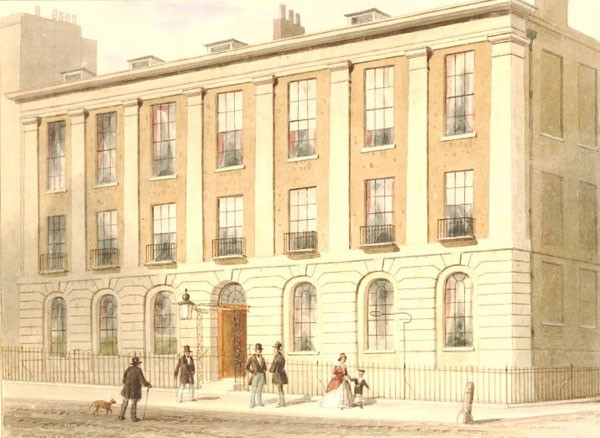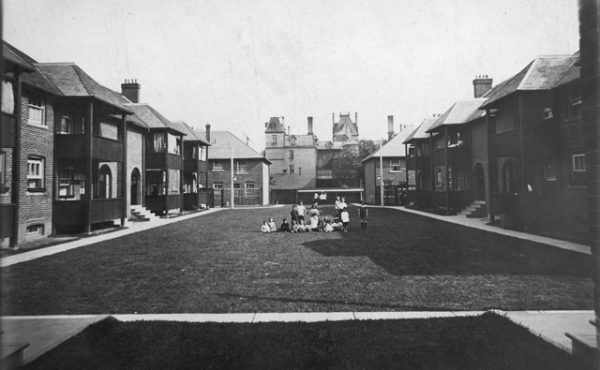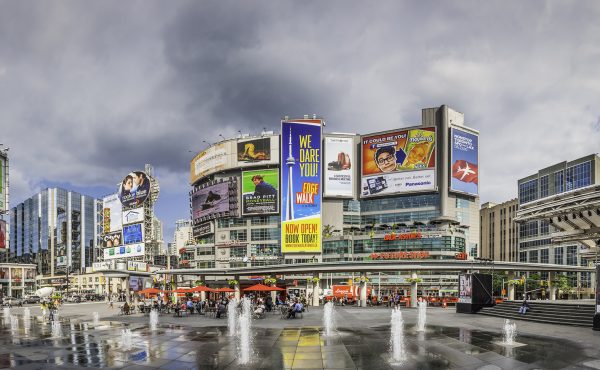There’s a spot right in the middle of London, England, with a long-forgotten connection to the history of Toronto. It’s on the Strand, on the edge of the financial district, just a few blocks from Trafalgar Square. Westminster is just around the bend of the River Thames. This is a busy place — just as it has been for hundreds of years. Traffic buzzes by. Pedestrians race to and from the nearby Temple tube station. An old Christopher Wren church spire rises high overhead. Today, the exact spot is under construction; there’s a new development going in. But in the very late 1700s and the very early 1800s, this corner was home to the Crown & Anchor tavern, a hotbed for radical politics with a special connection to one of the most conservative families from the early history of Toronto.
The story of William Jarvis starts far on the other side of the Atlantic — in Connecticut. This was back in the middle of the 1700s; back in the days when being an American meant you were British, too. And Jarvis liked it that way. He was deeply loyal to the Crown. When the American Revolution broke out, he was convinced the rebels were wrong. So, even though he was just a teenager, Jarvis joined the British army. He spent the next few years fighting against the Patriot rebels as a member of the Queen’s Rangers.
But Jarvis, of course, had picked the losing side of the war. And he paid a heavy price. At the end of the Revolution, he tried to return to his home in Connecticut. But he wasn’t welcome there anymore.
One day, while Jarvis and his family were on their way to a picnic, they were attacked by an angry mob of Patriots. That kind of thing was happening to Loyalists all over the brand new United States. Not long ago, pro-British opinions had been accepted as conventional wisdom; now, they were treason. Jarvis’ own sister was attacked over and over again in the wake of the Revolution; her home was invaded, her children threatened with bayonets, her husband eventually driven to suicide. While she and tens of thousands of others escaped north to the British colonies in Canada, William Jarvis fled across the Atlantic to England. He spent the next nine years living in London — in exile.
He wasn’t alone. Thousands of American Loyalists headed for the British Isles, including a young woman by the name of Hannah Owen Peters. She was the daughter of the Reverend Samuel Peters, a slave-owning Anglican preacher so famously reviled that more than two hundred years later, he got his own chapter in a book called Jerks in Connecticut History. He, too, had been driven out of his home by violent Patriot mobs. And he, too, came to London. Hannah followed him there.
So it was in England that William probably met Hannah for the first time (although they were both from important Connecticut families, so it could have been earlier). And it was in London that they got married. The ceremony was held at a church just a few blocks from Buckingham Palace: St. George’s, Hanover Square (the exact same spot where, a century later, Sir John A. Macdonald would marry his second wife while he was in town negotiating Confederation).
Soon, the new couple would become one of the founding families of Toronto. While the newlyweds were living in London with Hannah’s dad, Jarvis was still in close contact with his commanding officer from his days in the Queen’s Rangers: John Graves Simcoe. And when Simcoe was chosen as the first Lieutenant Governor of Upper Canada — a brand new province specifically created to be a home for Loyalist refugees — he picked Jarvis to be part of his government.
But that wasn’t the only new job Jarvis was going to have in the new province. And that’s where the Crown & Anchor tavern comes in.
In the late 1700s and early 1800s, the Crown & Anchor was one of the most important taverns in all of England. Some of the biggest names in Britain came to drink and to argue, to hold meetings and to give lectures: people like Samuel Taylor Coleridge, Samuel Johnson, William Godwin, Thomas Hardy and William Hazlitt. The tavern was especially famous as a hotbed for progressive politics. It became an icon of its time, synonymous with the Radicals and Reformers who were fighting to make England more democratic. Many of them were being thrown into prison for their ideas, some charged with treason and locked away in the Tower of London. At the Crown & Anchor, hundreds — sometimes even thousands — gathered in the elegant and spacious rooms, listening to speakers, holding meetings, or throwing a party when someone was finally released from jail. They used the tavern to print pamphlets and radical texts like Thomas Paine’s Rights of Man, a defence of the French Revolution. They were also ardent supporters of the American Revolution. In other words, they were the ideological opposites of William Jarvis.
But there was lots of space at the Crown & Anchor. Not everyone who held a meeting there was a radical. Far from it. And in the very late 1700s, the tavern was home to a series of meetings by the most famous secret organization in the world: The Freemasons.
A new province in Canada meant a new Grand Lodge. And the Freemasons in London just happened to have a brand new member who was going to be living there. William Jarvis had been inducted into the organization just a month earlier. So, at one of their meetings at the Crown & Anchor, they chose him to be the very first Provincial Grand Master of the Provincial Grand Lodge of Upper Canada.
Of course, the famous Masonic secrecy means that we can’t be entirely sure what kind of a Grand Master Jarvis was. But he also played a much more public role as a prominent member of another anti-democratic, conservative-minded group trying to concentrate power in the hands of a few well-connected members: The Family Compact. Over the course of Toronto’s first few decades, just a few Loyalist Tory families — the Jarvises among them — managed to keep most of the power in the new province to themselves, cracking down on anyone who argued in favour of democratic reform.
And when you read about Jarvis and his role in that early Toronto government, the same kind of adjectives keep popping up: “inefficient and careless,” “incompetent and corrupt,” “incompetent, lazy, selfish and dishonest.” Even worse than that, the Jarvis family was one of the very few families in the history of Toronto to own slaves. And when Simcoe wanted to outlaw the practice, the pro-slavery members of his government — including, presumably, Jarvis — forced a compromise that saw it gradually phased out instead.
The Jarvis family doesn’t seem to have gotten along very well with our city’s other founders, either. William once tried to challenge four men to a duel all at the same time; Hannah called the rest of the Toronto’s ruling class “a lot of Pimps, Sycophants and Lyars.” When one of the slaves escaped from the Jarvises, the man later wrote a letter to William explaining why: “your wife vexed me to so high a degree that it was far beyond the power of man to support it…”
One of their sons, Samuel Jarvis, inherited their confrontational attitude. As a young man, he infamously killed a teenager in a duel under suspicious circumstances — probably over gambling debts. And as a member of the Family Compact, he became one of the archenemies of William Lyon Mackenzie. The rebel mayor’s politics had been deeply influenced by the American Revolution and those same Crown & Anchor reformers; he’d even met at least one of them during a trip to England and used his own Torontonian newspaper to print the writings of Thomas Paine, just like they’d done in London. Mackenzie drove the Jarvis family nuts. In fact, he was the one who came up with the derisive “Family Compact” nickname.
Once, when Mackenzie called Samuel Jarvis a murderer for killing the teenager in the duel, the young Jarvis struck back. In a bizarre echo of the Patriot attacks that had terrorized his own family in the United States, he organized an angry mob, dressed them up in a parody of First Nations clothing, and attacked Mackenzie’s home and business while he was out of town. Mackenzie’s family was there, though; they hid in fear while the rioters destroyed the printing press and threw the type into Lake Ontario.
But the Type Riot backfired. Mackenzie sued and got a big settlement, enough to expand his newspaper business. Now, his radical politics had an even bigger voice. Within a few short years, he’d become the very first mayor of Toronto and led an armed rebellion against British rule. On the day Mackenzie marched his army down Yonge Street, the Jarvis family was there again, taking up arms just as they’d done in the United States sixty years earlier. In fact, it was a ragtag force led by their cousin — Sheriff William Botsford Jarvis — who turned Mackenzie’s rebels away.
Still, the days of the Family Compact were numbered. Real democracy was going to come to Canada anyway. And despite having to spend years in exile, Mackenzie would be a leading voice in Canadian politics for decades to come. In a weird twist, thanks to the Type Riot, it was the conservative Jarvis family who helped to make it happen. But while Mackenzie is still one of the most famous figures from the history of our city, we barely remember William Jarvis and his family at all. For most of us, the Grand Master, soldier, refugee and politician is nothing more than a name on a street sign, whose story was forgotten long ago. Most people in Toronto don’t know him much better than those busy Londoners do, rushing past the spot where he was chosen to lead our city’s first Masonic Lodge more than two hundred years ago.
Learn more about London’s Toronto-related historical spots with our Torontonian historical map of London, England.
A version of this post originally appeared on the The Toronto Dreams Project Historical Ephemera Blog. You can find more sources, images, links and related stories there.
Image: The Crown & Anchor Tavern.





2 comments
For anyone interested in Toronto’s history, parts of this story are well-known. I didn’t know about his membership in the Freemasons, but it comes as no surprise.
P.S. “solider”? s/b soldier I think.
Thanks for catching that! I’ve updated the post.